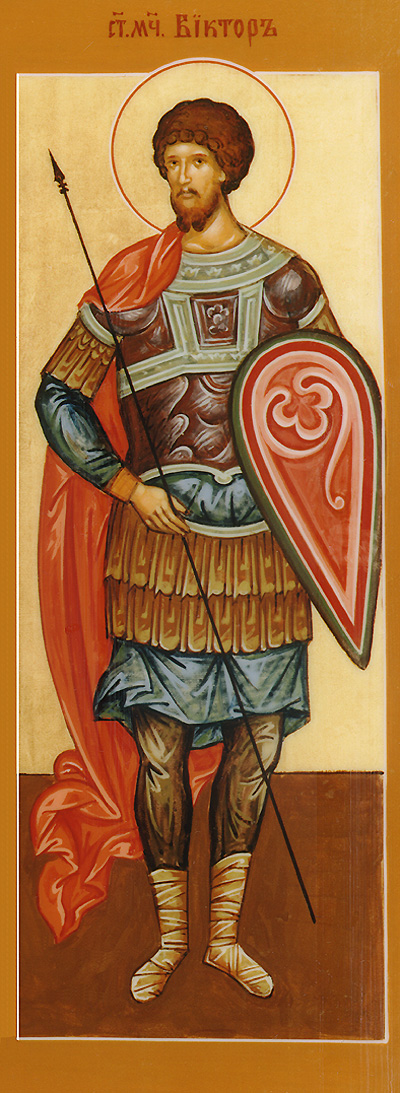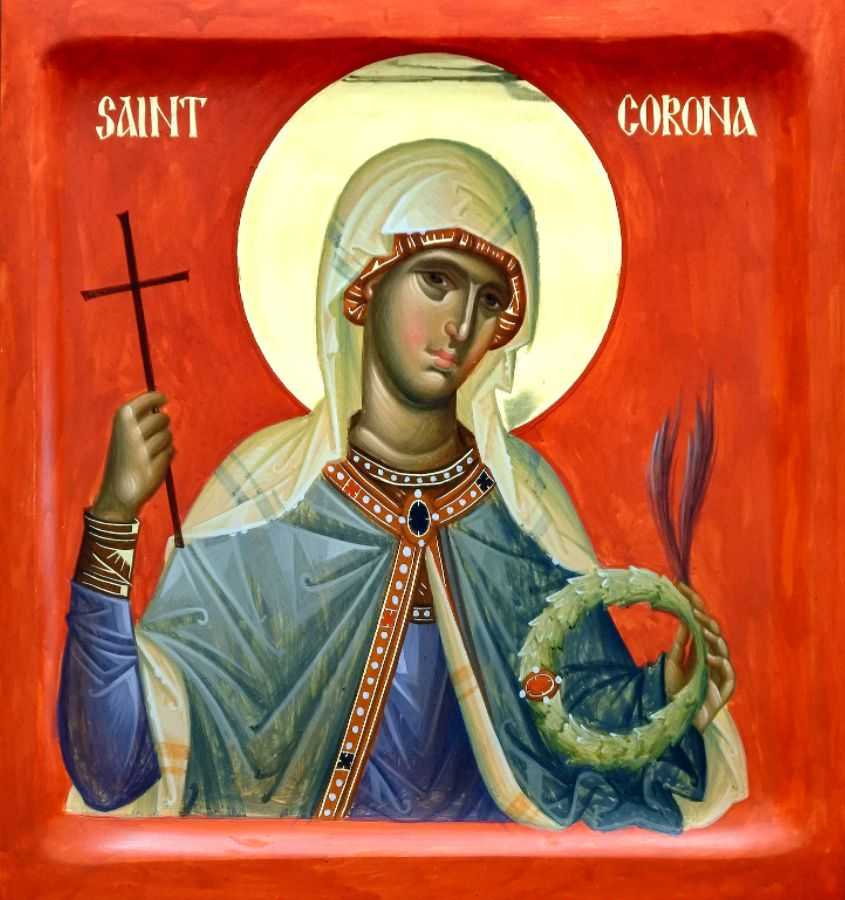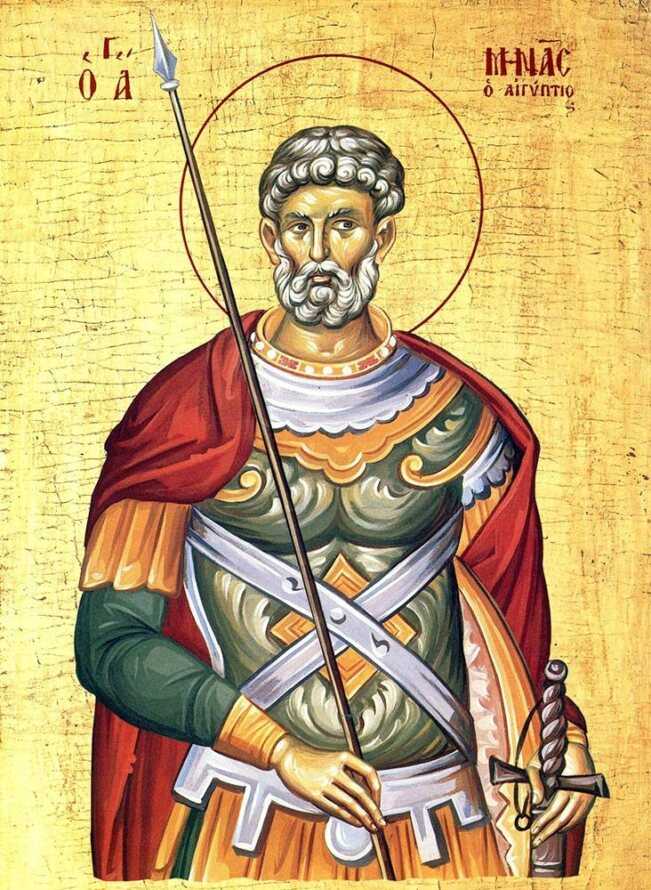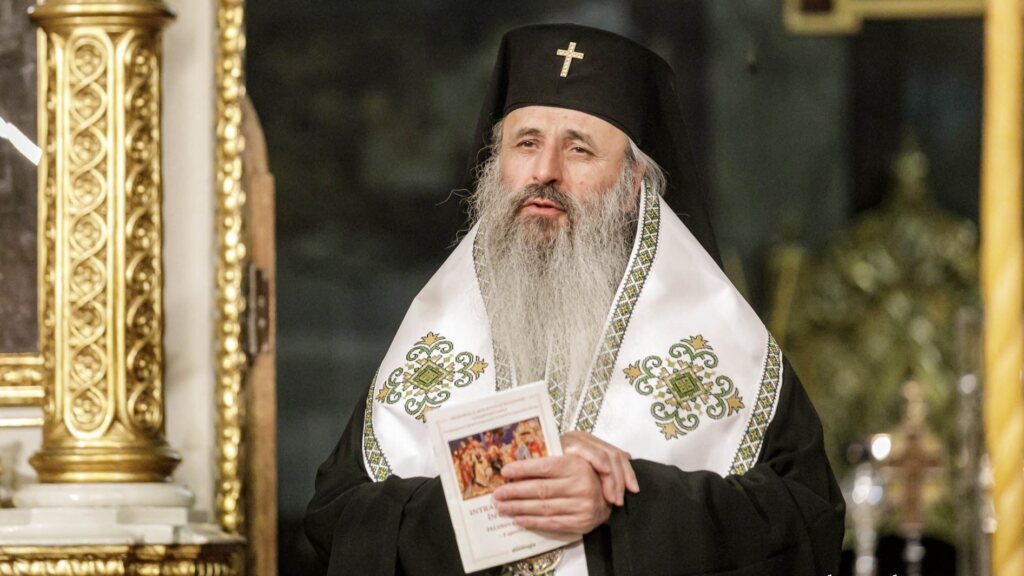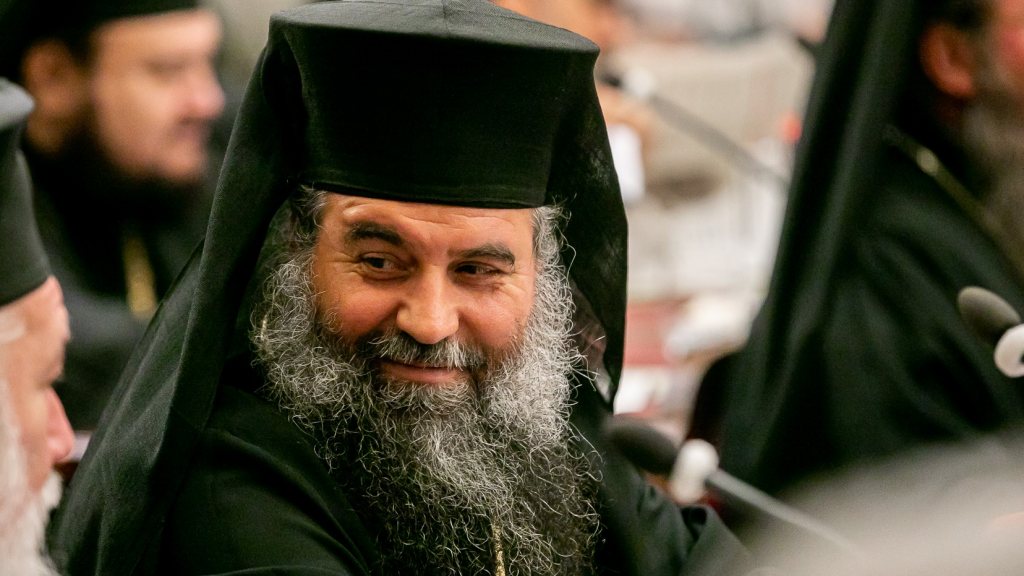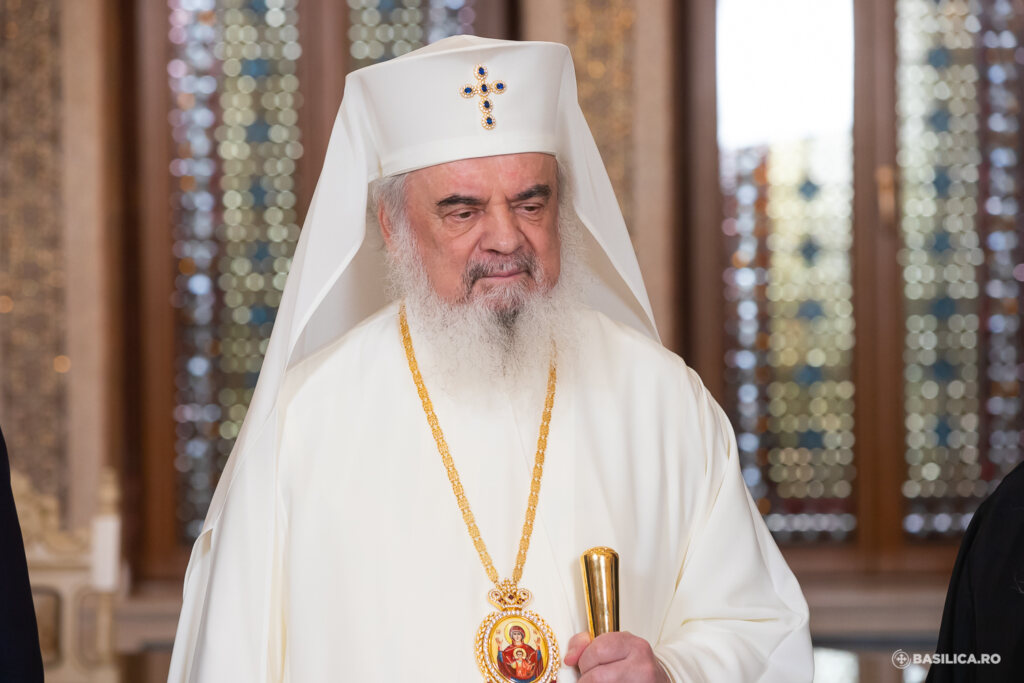Holy Great Martyr Menas of Egypt
An Egyptian by birth, was a military officer and served in the Kotyaeion region of Phrygia under the centurion Firmilian during the reign of the emperors Diocletian (284-305) and Maximian (305-311). When the emperors began the fiercest persecution against Christians in history, the saint refused to serve these persecutors. He removed his soldier’s belt (a sign of military rank) and withdrew to a mountain, where he lived an ascetic life of fasting and prayer.
Once he happened to arrive in the city during a pagan festival. At the climax of the games the saint’s accusing voice rang out, preaching faith in Christ, the Savior of the world. At his trial before the prefect Pyrrhus, the saint bravely confessed his faith, saying that he had come to denounce the impious. The prefect was angered, and had Menas arrested.
Pyrrhus offered to restore the saint’s former rank if he would offer sacrifice to the pagan gods. When he refused, he was put to cruel tortures, then he was beheaded. This occurred in the year 304. Christians gathered up the martyr’s relics by night and hid them until the end of the persecution. Later, they were brought to Egypt and placed in a church dedicated to Saint Menas southwest of Alexandria.
The saint received grace from God to work miracles, and to help those in need. Saint Menas is noted for healing various illnesses, delivering people from possession by demons, and as a protector, especially during times of war. We also ask his help in finding lost objects.
Troparion — Tone 4
Your holy martyrs, O Lord, / through their sufferings have received incorruptible crowns from You, our God. / For having Your strength, they laid low their adversaries, / and shattered the powerless boldness of demons. / Through their intercessions, save our souls!
Holy Martyr Victor at Damascus
He was a soldier during the reign of the emperor Marcus Aurelius the Philosopher (161-180). When the emperor began a persecution against Christians, Victor refused to offer sacrifice to the pagan gods. Such obligatory sacrifices were a test of a soldier’s loyalty to the gods, the emperor and the state. The saint was given over to torture, but he came through all the torments unharmed. By the power of prayer he was victorious over a sorcerer, who from that point gave up give sorcery and became a Christian.
Through Saint Victor’s prayers, blind soldiers suddenly received their sight. Witnessing the miracle worked by the Lord through Saint Victor, Stephanida, the young Christian wife of one of the torturers, openly glorified Christ, for which she was condemned to a cruel death. She was tied to two palm trees bent to the ground, which when released, sprung back and tore her apart. She was fifteen years old.
The torturer ordered that the holy Martyr Victor be beheaded. Hearing the commander’s order, Saint Vincent told his executioners that they would all die in twelve days, and that the commander would be captured by the enemy in twenty-four days. As he foretold, so it came to pass.
The martyrs suffered in the second century at Damascus, where their venerable relics were buried.
Holy Martyr Vincent of Spain
From his childhood, he was the disciple of a wise pastor Valerian, the bishop of the city of Augustopolis (now Saragossa, Spain). When he reached mature age, the virtuous, educated and eloquent Vincent was ordained deacon by Bishop Valerian. Since the bishop himself was not adept in speech, he gave a blessing to his deacon, an eloquent orator, to preach in church and among the people.
Diocletian (284-305) sent the governor Dacian to the city of Valencia, Spain with full authority to find and execute Christians. People denounced the wise bishop and his deacon to the governor, who arrested them. The soldiers, mounted on horses, dragged the Elder and his disciple behind them in chains from Augustopolis to Valencia, and there they cast them into prison beaten and tortured, giving them neither food nor water.
They subjected the bishop to the first interrogation. The Elder spoke quietly, but seemed tongue-tied and uncertain. Then Saint Vincent came forward and made the most eloquent speech of his life before the judges and assembled people. After he sent the bishop back to prison, the persecutor gave orders to torture the holy deacon.
The martyr underwent many torments: while nailed to a cross, he was whipped and burned with red-hot rods. When he was removed from the cross, he then himself joyfully climbed back upon it, saying that the executioners were lazy and had not fulfilled their master’s orders. They became angry and tortured him again, until they were all exhausted.
After the tortures they threw the martyr back into prison. That night the astonished guard heard him singing Psalms, and saw an unearthly radiant light in the prison. The next morning the holy martyr was condemned to be burned on a gridiron. Christians took the saint’s body and buried it with reverence. This occurred in the year 304.
Saint Stephanida
She witnessed the martyrdom of the Holy Martyr Victor at Damascus, a soldier during the reign of the emperor Marcus Aurelius the Philosopher (161-180). He was tortured, but he came through all the torments unharmed. By the power of prayer he was victorious over a sorcerer, who from that point gave up give sorcery and became a Christian.
Through Saint Victor’s prayers, blind soldiers suddenly received their sight. Witnessing the miracle worked by the Lord through Saint Victor, Stephanida, the young Christian wife of one of the torturers, openly glorified Christ, for which she was condemned to a cruel death. She was tied to two palm trees bent to the ground, which when released, sprung back and tore her apart. She was fifteen years old.
The martyrs suffered in the second century at Damascus, where their venerable relics were buried.
Troparion of Holy Martyrs Victor, Vincent and Stephanida — Tone 4
Your holy martyrs, O Lord, / through their sufferings have received incorruptible crowns from You, our God. / For having Your strength, they laid low their adversaries, / and shattered the powerless boldness of demons. / Through their intercessions, save our souls!
Saint Theodore the Confessor, Abbot of the Studion
He was born in the year 758 at Constantinople into a family of the imperial tax-collector Photinus and his spouse Theoctiste, both pious Christians. Saint Theodore received a good education from the best rhetoricians, philosophers and theologians in the capital city.
During this time the Iconoclast heresy had become widespread in the Byzantine Empire, and it was supported also by the impious emperor Constantine Kopronymos (741-775). The views of the emperor and his court conflicted with the religious beliefs of Photinus, who was a fervent adherent of Orthodoxy, and so he left government service. Later, Saint Theodore’s parents, by mutual consent, gave away their substance to the poor, took their leave of each other and accepted monastic tonsure. Their son Theodore soon became widely known in the capital for his participation of the numerous disputes concerning icon-veneration.
Saint Theodore was accomplished in oratory, and had a command of the terminology and logic of the philosophers, so he frequently debated with the heretics. His knowledge of Holy Scripture and Christian dogma was so profound that no one could get the better of him.
The Seventh Ecumenical Council put an end to dissension and brought peace to the Church under the empress Irene. The Ecumenical Council, as the highest authority in the life of the Church, forever condemned and rejected Iconoclasm.
Among the Fathers of the Council was Saint Platon (April 5), an uncle of Saint Theodore, and who for a long time had lived the ascetic life on Mount Olympos. An Elder filled with the grace of the Holy Spirit, Saint Platon, at the conclusion of the Council, summoned his nephew Theodore and his brothers Joseph and Euthymius to the monastic life in the wilderness.
After leaving Constantinople, they went to Sakkoudion, not far from Olympos. The solitude and the beauty of the place, and its difficulty of access, met with the approval of the Elder and his nephews, and they decided to remain here. The brothers built a church dedicated to Saint John the Theologian, and gradually the number of monks began to increase. A monastery was formed, and Saint Platon was the igumen.
Saint Theodore’s life was truly ascetic. He toiled at heavy and dirty work. He strictly kept the fasts, and each day he confessed to his spiritual Father, the Elder Platon, revealing to him all his deeds and thoughts, carefully fulfilling all his counsels and instructions.
Theodore made time for daily spiritual reflection, baring his soul to God. Untroubled by any earthly concern, he offered Him mystic worship. Saint Theodore unfailingly read the Holy Scripture and works of the holy Fathers, especially the works of Saint Basil the Great, which were like food for his soul.
After several years of monastic life, Saint Theodore was ordained a priest according to the will of his spiritual Father. When Saint Platon went to his rest, the brethren unanimously chose Saint Theodore as Igumen of the monastery. Unable to oppose the wish of his confessor, Saint Theodore accepted the choice of the brethren, but imposed upon himself still greater deeds of asceticism. He taught the others by the example of his own virtuous life and also by fervent fatherly instruction.
When the emperor transgressed against the Church’s canons, the events of outside life disturbed the tranquility in the monastic cells. Saint Theodore bravely distributed a letter to the other monasteries, in which he declared the emperor Constantine VI (780-797) excommunicated from the Church by his own actions for abusing the divine regulations concerning Christian marriage.
Saint Theodore and ten of his co-ascetics were sent into exile to the city of Thessalonica. But there also the accusing voice of the monk continued to speak out. Upon her return to the throne in 796, Saint Irene freed Saint Theodore and made him igumen of the Studion monastery (dedicated to Saint John the Baptist) in Constantinople, in which there were only twelve monks. The saint soon restored and enlarged the monastery, attracting about 1,000 monks who wished to have him as their spiritual guide.
Saint Theodore composed a Rule of monastic life, called the “Studite Rule” to govern the monastery. Saint Theodore also wrote many letters against the Iconoclasts. For his dogmatic works, and also for his Canons and Three-Ode Canons, Saint Theoctistus called Saint Theodore “a fiery teacher of the Church.”
When Nicephorus seized the imperial throne, deposing the pious Empress Irene, he also violated Church regulations by restoring to the Church a previously excommunicated priest on his own authority. Saint Theodore again denounced the emperor. After torture, the monk was sent into exile once again, where he spent more than two years.
Saint Theodore was freed by the gentle and pious emperor Michael, who succeeded to the throne upon the death of Nicephoros and his son Staurikios in a war against barbarians. Their death had been predicted by Saint Theodore for a long while. In order to avert civil war, the emperor Michael abdicated the throne in favor of his military commander Leo the Armenian.
The new emperor proved to be an iconoclast. The hierarchs and teachers of the Church attempted to reason with the impious emperor, but in vain. Leo prohibited the veneration of holy icons and desecrated them. Grieved by such iniquity, Saint Theodore and the brethren made a religious procession around the monastery with icons raised high, singing of the troparion to the icon of the Savior Not-Made-by-Hands (August 16).
The emperor angrily threatened the saint with death, but he continued to encourage believers in Orthodoxy. Then the emperor sentenced Saint Theodore and his disciple Nicholas to exile, at first in Illyria at the fortress of Metopa, and later in Anatolia at Bonias. But even from prison the confessor continued his struggle against heresy.
Tormented by the executioners which the emperor sent to Bonias, deprived almost of food and drink, covered over with sores and barely alive, Theodore and Nicholas endured everything with prayer and thanksgiving to God. At Smyrna, where they sent the martyrs from Bonias, Saint Theodore healed a military commander from a terrible illness. The man was a nephew of the emperor and of one mind with him. Saint Theodore told him to repent of his wicked deeds of Iconoclasm, and to embrace Orthodoxy. But the fellow later relapsed into heresy, and then died a horrible death.
Leo the Armenian was murdered by his own soldiers, and was replaced by the equally impious though tolerant emperor Michael II Traulos (the Stammerer). The new emperor freed all the Orthodox Fathers and confessors from prison, but he prohibited icon-veneration in the capital.
Saint Theodore did not want to return to Constantinople and so decided to settle in Bithynia on the promontory of Akrita, near the church of the holy Martyr Tryphon. In spite of serious illness, Saint Theodore celebrated Divine Liturgy daily and instructed the brethren.
Foreseeing his end, the saint summoned the brethren and bade them to preserve Orthodoxy, to venerate the holy icons and observe the monastic rule. Then he ordered the brethren to take candles and sing the Canon for the Departure of the Soul From the Body.
Just before singing the words “I will never forget Thy statutes, for by them have I lived,” Saint Theodore fell asleep in the Lord, in the year 826. At the same hour Saint Hilarion of Dalmatia (June 6) saw a vision of a heavenly light during the singing and the voice was heard, “This is the soul of Saint Theodore, who suffered even unto blood for the holy icons, which now departs unto the Lord.”
Saint Theodore worked many miracles during his life and after his death. Those invoking his name have been delivered from fires, and from the attacks of wild beasts, they have received healing, thanks to God and to Saint Theodore the Studite. On January 26 we celebrate the transfer of the relics of Theodore the Studite from Cherson to Constantinople in the year 845.
Those with stomach ailments entreat the help of Saint Theodore.
Troparion — Tone 8
O champion of Orthodoxy, teacher of purity and of true worship, / the enlightener of the universe and the adornment of the hierarchs: / O all-wise Father Theodore, your teachings have gleamed with light upon all things. / Intercede before Christ our God to save our souls!
Tr by oca.org
